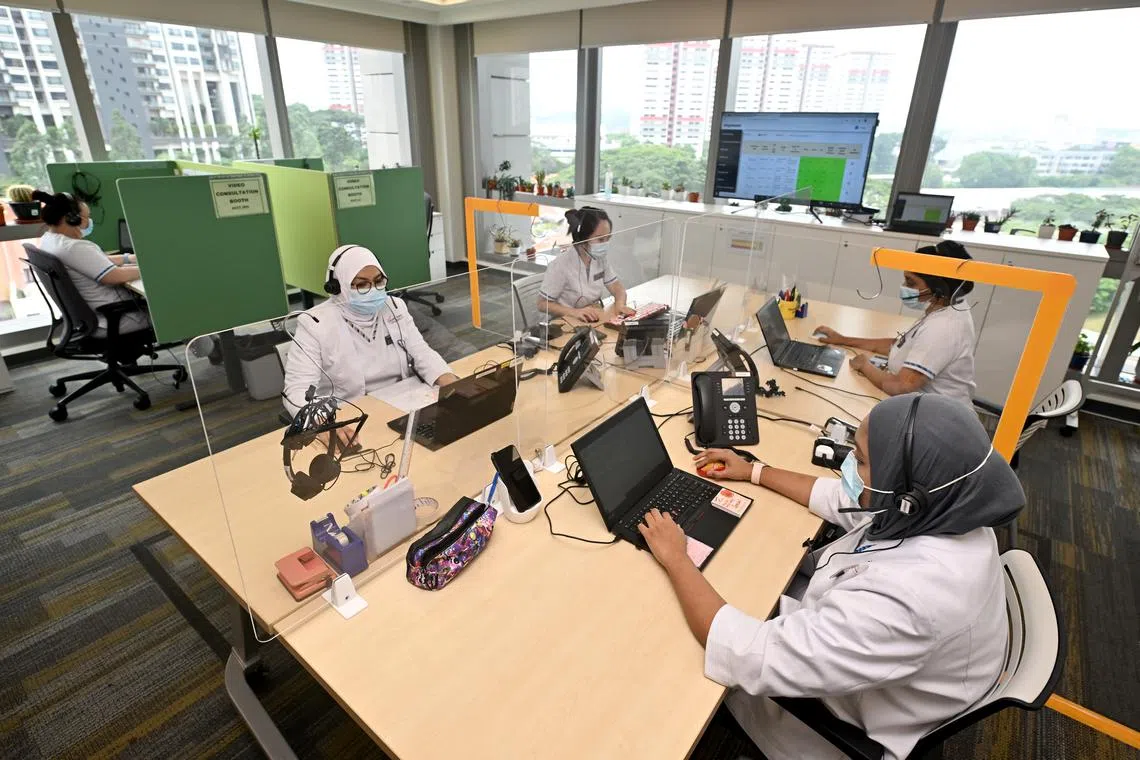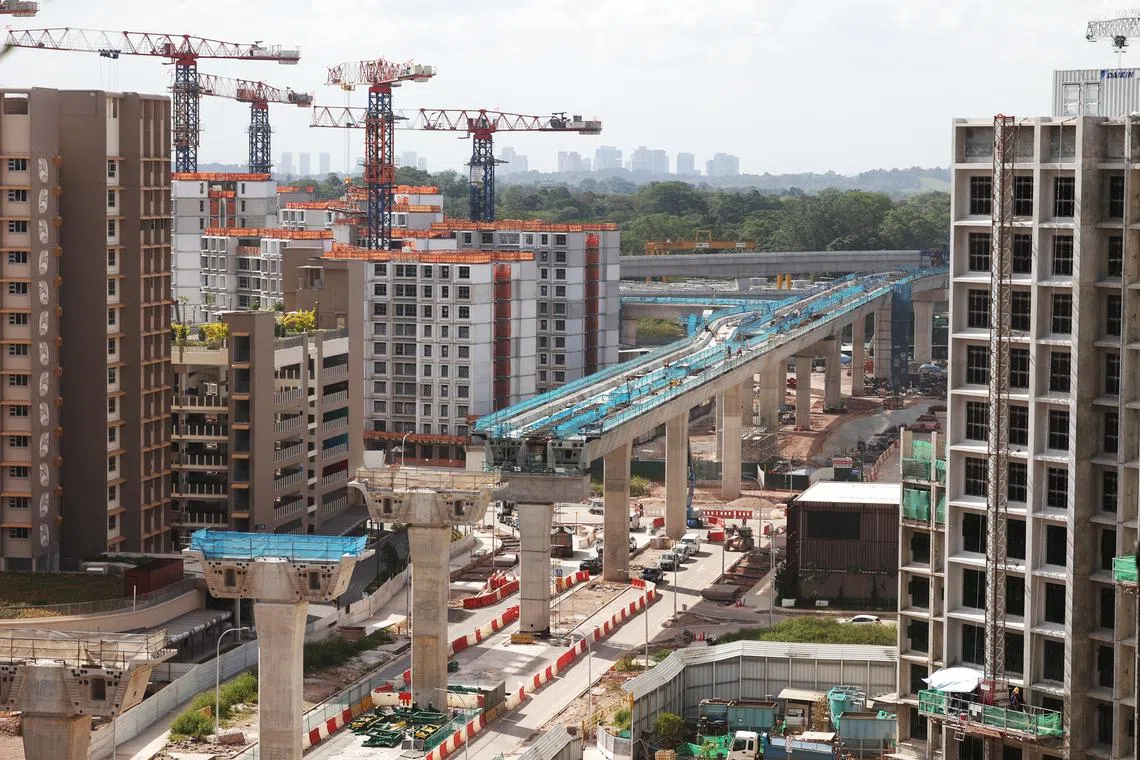Subsidised hospital care in the comfort of home from April 1; new hospital in Tengah by early 2030s
Sign up now: Get ST's newsletters delivered to your inbox

Nurses doing video consultations and reviewing patients' conditions at the SGH@Home Command Centre in September 2022.
PHOTO: ST FILE
Follow topic:
SINGAPORE – Patients who opt for hospital-level care at home will be subsidised and can use their MediSave healthcare savings, as well as insurance payouts from MediShield Life and Integrated Shield Plans, to pay for it from April 1.
This, Health Minister Ong Ye Kung said, will turn the service, called Mobile Inpatient Care @ Home (MIC@Home),
Also, to serve the medical needs of the country’s growing population, the Ministry of Health (MOH) has a new integrated general and community hospital in the pipeline for Tengah town in the west of Singapore. It will be ready in the early 2030s.
These are some of the strategies to expand the country’s healthcare capacity, said Mr Ong in his speech on his ministry’s budget on March 6.
In Singapore, what is driving up hospital bed occupancy is the increased number of seniors with complex conditions post-Covid-19, he said.
The average length of stay went up from about six days pre-Covid-19 to seven days post-Covid-19, which alone represents a 15 per cent increase in patient load, he noted.
“This is happening against the backdrop of a rapidly ageing population, which compounds the problem and makes it a long-term challenge,” he said.
Three MPs, including Leader of the Opposition Pritam Singh, had raised the issue of capacity and waiting times at hospitals.
Suggestions included dynamic waiting times at hospital emergency departments and deploying more urgent care centres, which are meant for people who need urgent treatment for non-life-threatening illnesses.
Mr Ong told the House that ambulances already have a process in place to ferry patients needing urgent care to the nearest appropriate hospital for priority treatment. However, 40 per cent of cases at the emergency departments are not life-threatening or urgent.
“So our worry is that giving dynamic information may perversely drive more non-urgent cases to hospitals and worsen the overall situation,” Mr Ong said.
To help ease the bed crunch, the ministry is expanding its MIC@Home pilot project – where virtual hospital beds are set up in the homes of patients, who can enjoy round-the-clock access to care delivered by a team of healthcare professionals through teleconsultations and home visits, until they are considered fit for discharge.
Having done the pilot for several months, MOH is convinced the scheme works well for the patients and has great potential to relieve the stress at hospitals, Mr Ong said.
As at end-2023, more than 2,000 have benefited from the service, translating into about 9,000 hospital bed days saved, he revealed.
With the move to make MIC@Home a recognised and accepted part of Singapore’s public healthcare institutions, Mr Ong said patients can be assured they will not pay any more for it than they do for acute inpatient care at a public hospital.
“All our hospitals intend to price MIC@Home similar to or lower than a normal hospital ward. Patients will be supported by subsidies, MediShield Life and MediSave, no different from a physical inpatient stay,” he said.
Responding to opposition MP Jamus Lim’s suggestion to give an incentive for transition to home care, Mr Ong said he does not see the need to do so.
“It will be better to develop MIC@Home into a well-accepted mainstream mode for acute inpatient care.”
He said that as a first step, the capacity of MIC@Home will be expanded from 100 virtual beds in 2023 to 300 in 2024, with potential to scale up further.
Even as Singapore shifts care beyond hospitals, Mr Ong said the Republic will continue to invest in infrastructure to ensure it can meet healthcare needs.
Such investments include the new integrated general and community hospital in Tengah to serve the growing population in the western part of Singapore.

The Ministry of Health has a new integrated general and community hospital in the pipeline for Tengah town in the west of Singapore. It will be ready in the early 2030s.
PHOTO: LIANHE ZAOBAO
MOH also plans to establish a new not-for-profit private hospital catering mainly to Singaporeans from 2030.
While industry consultation is under way, Mr Ong said the hospital will provide cost-effective quality care but with stronger governance over its doctors’ clinical practices.
There are now more than 11,000 public hospital beds. To meet the needs of Singapore’s rapidly ageing population, another 4,000 beds will be added, with new capacity coming on stream every year from now to 2030, Mr Ong said.
These include Woodlands Health ramping up to 700 beds in 2024 and 2025, and Sengkang General and Outram Community hospitals growing by about 350 beds in total by converting some non-clinical spaces into hospital wards from 2026.
Within the Outram campus, the Singapore General Hospital Elective Care Centre will open in 2027 with 300 beds.
The redeveloped Alexandra Hospital will progressively open in 2028 and 2029, and the new Eastern General Hospital campus in Bedok North, which comprises a new integrated general and community hospital, will open gradually in 2029 and 2030.
“We should not be trapped in the mindset of ‘building hospitals’ when thinking about capacity. There is potential to better anchor care outside of hospitals, and in the community,” Mr Ong said.
“Not all patients require high acuity care and constant monitoring in a hospital throughout their treatment course.
“Many need convalescent care and rehabilitation, with the assurance that additional medical help is readily available nearby.”
To facilitate appropriate transfers from acute hospitals to community settings, there will be more funding for community hospitals.
Mr Ong said acute hospitals have experienced difficulty in transferring suitable patients to community hospitals as certain diagnostic services such as CT and MRI scans, and certain more expensive drugs, are not subsidised at community hospitals.
To remove this friction, these diagnostic services and relevant drugs will be subsidised at community hospitals from the last quarter of 2024, aligning the community hospital subsidy framework with that of acute hospitals.
This is so that patients receive the same subsidy rate of 50 per cent to 80 per cent throughout their inpatient stay.
With this enhancement, most community hospital patients will see smaller hospital bills, Mr Ong said.


